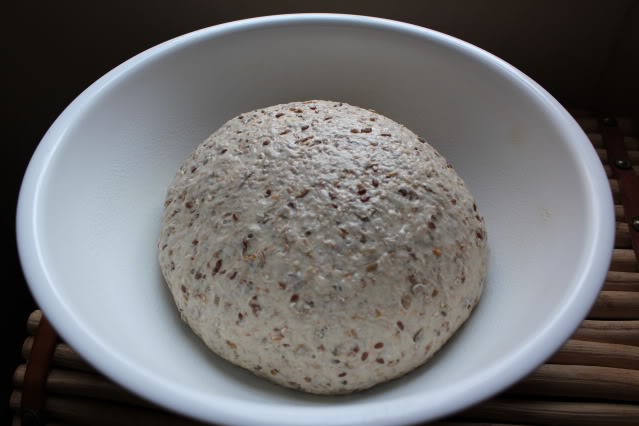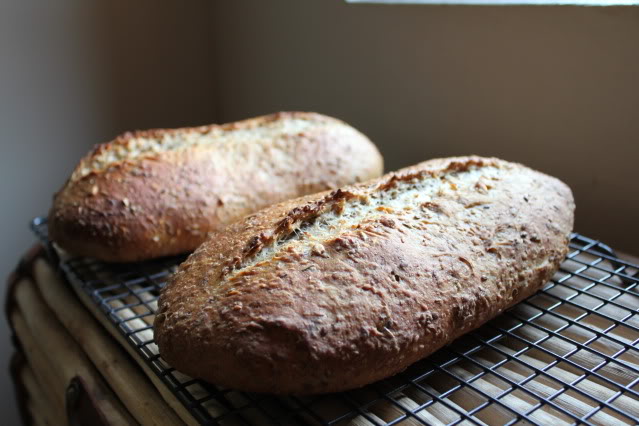Because of some scheduled maintenance on my car, I had to work from home one day a week or two ago. That afforded me an opportunity to accomplish a couple of additional objectives: first, clear out some of the pantry contents in preparation for my pending move and second, make some bread. As it turned out, that also became my last bake in South Africa.
In terms of the pantry, there was just enough rye flour to make a small rye sour, a couple of kilos of crushed rye, sunflower seeds, flax seeds, sesame seeds, whole wheat flour and bread flour. While I couldn’t use up everything in a single bake, I was able to put together a formula that utilized all of those ingredients to some extent. I thought that I would aim for something around 70% hydration, on the assumption that the resulting dough would be somewhat slack but still have enough body to carry the load of the crushed rye and seeds. After some measuring and calculating, the draft formula looked like this:
Rye Sour
42g white starter (mine was roughly 60% hydration and there’s nothing magical about using exactly 42g)
140g whole rye flour
140g water
Soaker
200g crushed rye (cracked rye or rye chops would work just as well)
50g sunflower seeds
50g flax seeds
50g sesame seeds
350g boiling water
Final Dough
All of the rye sour
All of the soaker
450g water
150g whole wheat flour
850g bread flour
13g yeast
20g salt
The rye sour ingredients were thoroughly mixed the evening before baking day and covered while fermenting at room temperature (in the upper 60’s F). The next morning, the sour was noticeably puffy, though nowhere near doubled. When I poured in the water for the final dough, the sour detached from the bottom of the bowl and floated to the top.
The soaker ingredients were mixed the morning of baking day, covered, and allowed to cool until they were just warm to the touch.
The final dough was assembled and baked as follows:
- The rye sour, the soaker, and the water were combined and thoroughly mixed.
- The remaining flours, yeast and salt were added to the sour/soaker/water mixture and mixed until thoroughly combined. The dough was sludgy and stiff, more like a rye dough than a wheaten dough.
- The resulting dough was quite a bit stiffer than I wanted, so I began adding water and mixing and kneading to incorporate the water. Some 25 minutes and probably another 50g of water later, I called it good enough. My initial thought had been to arrive at a dough that was slack enough to handle with stretch and folds. That may not be a realistic goal, given the quantity of crushed rye and seeds. This dough required a lot of muscle to perform the usual push/turn/fold method of kneading.
- The dough was placed in a greased bowl, covered, and allowed to ferment until doubled in volume.
- After gently degassing the dough, I shaped it into two batards. Boules would probably have worked just as well but my gear, including bannetons, was somewhere between Johannesburg and Kansas City. Since I had to improvise, I placed the shaped loaves on a parchment lined baking sheet and covered them, allowing them to ferment until they were nearly doubled in size. It was about that time that the dealership let me know that the car was ready. Plan B, then, accompanied by much muttering. I placed the loaves in the refrigerator and hoped that they wouldn’t over-proof before I got back.
- A little more than an hour had elapsed by the time I got back to the house. The loaves looked a bit wobbly. More muttering. I preheated the oven (and steam pan) to 230C/450F which proceeded as it usually did, which is to say sl-o-o-o-o-wly. Taking the loaves out of the refrigerator, I tried to slash them with the sharpest of the dull knives that were available to me, which caused a visible settling of the loaves and not much of a cut. Quickly dumping some boiling water into the steam plan, I then manuevered the sheet pan with the loaves into the oven as gently as possible and left them to themselves for about 45 minutes. During that time they regained about half of the volume they lost when slashed.
- When the loaves were done to the eye and the ear (the instant read thermometer was in the same crate as the bannetons and knives, remember), they were removed from the oven and allowed to cool on a wire rack, covered with a towel.
Dough at beginning of bulk ferment:

Dough at end of bulk ferment:

Finished loaves:

On the plus side, this is a very good bread, particularly with regard to flavour. Lots of earthy notes from the rye while the sunflower seeds provide a more mellow richness. The flax and sesame seeds each contribute to the crunch factor. Surprisingly, this is not a tough bread. Neither is it dry. It is, however, very substantial, requiring real chewing. Given the lengthy kneading, the crumb is very even, composed of small cells. In spite of the high percentage of bread flour, it reminds me more of a vollkornbrot. It definitely feels like a vollkornbrot in the stomach; thin slices are just fine, thank you. I can report that it plays very nicely with ham and cheese but tends to overwhelm smoked chicken breast.
There are a number of things to address if I am able to try this again once I’m back in the States. The first is to bump up the hydration. Pushing it to 85% may not be too much. That might loosen the dough enough to permit use of the stretch and fold technique and gain a more open crumb. Then again, it may be too soft to carry the soaker successfully. Maybe, just maybe, a bit of sweetener would bring some of the grainy flavours forward; perhaps a drizzle of honey or molasses, or a combination of the two. Not tolerating any interruptions between final fermentation and baking will be important, too. If the ambient temperatures are in the 70’s F or higher, going entirely sourdough with no commercial yeast is also an option. Depending on moisture content, some alterations to the baking profile may also be required. For instance, a wetter dough with some sweetener in it might want the high initial temperature for the first 15 minutes or so to drive oven spring, which would then have to be dialled back to prevent the crust from burning before the interior is thoroughly baked. Hmm, I’m going to have to reacquaint myself with U.S. flours. That may push things in unexpected directions, too.
Considering that the whole thing was jerry-rigged from start to finish, I’m reasonably happy with the outcome. Probably the biggest frustration is that it over-proofed during the final fermentation. Even with that happening, the bread is not crumbly at the top and dense at the bottom. If I can source the ingredients (I’ve not had much luck locating rye chops or crushed/cracked rye in stores back home), I’ll definitely take another run or three at this to see whether I can come up with something that I can produce reliably. If any of you want to try some variations on the theme, let me know how things go, please.
- pmccool's Blog
- Log in or register to post comments
Hi Paul,
Love the crunchy bread. It's been really enjoyable reading your posts from South Africa, and I'm sure you'll have mixed feelings about moving on.
Best wishes
Andy
mixed feelings and mixed seeds ! Your posts are always so informative and enjoyable. You must continue after the return home. I don't use flax but other than that your formula has definite possibilities. Be safe on your return trip. c
Last night featured dinner and farewells with friends. More of the same this evening with other friends. Although I am wearying of saying goodbye so much, I must admit that it is far better to have made so many new friends who make leaving so difficult than it is to slink out of town with nothing more than a sigh of relief to show for two years of life in a place.
I am positively, absolutely straining against the leads to get back home again, though. To be with my wife and our families and friends; to sleep in my own bed in my own house; to taste familiar flavors; to be back in the US of A once more. It's all good! Even if I do have to retrain myself to drive on the proper side of the road once again.
Andy - the bread does have a pleasing crunch! It's been fun to be adventuring here, even on the days that I go no further than my kitchen.
Caroline - there's nothing binding about the choice of seeds. Those were simply what I had in my pantry that day. I see that I'm part of a surge in posts about seeded breads this week. It must be one of those convergences that occur sometimes.
Thanks for your well-wishes.
Paul
What a series of wonderful posts from SA! They have been really enjoyable, thank you. Your loaves look wonderful and I expect that they tasted wonderful as well!
As for driving on the wrong side of the road, that's what they do in America - but you will easily get the hang of it beause they also have the steering wheel on the wrong (left) side :) .
Have a safe journey home (and safe driving when you get there). I expect we will hear less from you for a few weeks - mores the pity.
Best Wishes Ruralidle